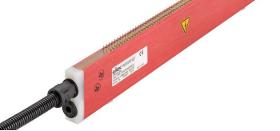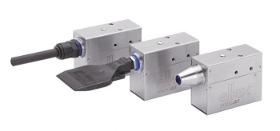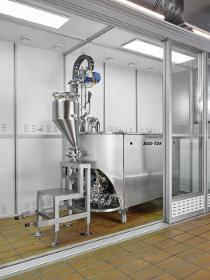- europages
- >
- COMPANIES - SUPPLIERS - SERVICE PROVIDERS
- >
- electrodes
Results for
Electrodes - Import export

KERSTEN ELEKTROSTATIK GMBH
Germany
The DE 206 is our most popular discharging electrode. It ensures the effective elimination of existing static charge on different materials and optimizes your processes.
Request for a quote
KERSTEN ELEKTROSTATIK GMBH
Germany
The smallest from the house of KERSTEN. Through the electrode's extremely small design and because it has the smallest cross section on the market, the DE 106 is suited for the smallest of application spaces.
Request for a quote
KERSTEN ELEKTROSTATIK GMBH
Germany
The charging electrodes CE 103, with GFP profiles, are used for the surface charging of different materials. A supply voltage of ±30kV should not be exceeded. Attachment of the charging electrode is carried out via a T-Slot. So, they can be mounted anywhere.
Request for a quote
KERSTEN ELEKTROSTATIK GMBH
Germany
The charging electrodes CE 103L, with GFP profiles, are used for the surface charging of different materials. A greater operating distance can be achieved through the air assistance. A supply voltage of ±30kV should not be exceeded. Attachment of the charging electrode is carried out via a T-Slot. So, they can be mounted anywhere.
Request for a quote
KERSTEN ELEKTROSTATIK GMBH
Germany
The DE 406 EX KERSTEN neXt® discharge electrode is a highly stable universal electrode for a variety of applications in ATEX zones. It is used for surface discharging a variety of materials. The mechanically stable aluminium profile design renders it suitable for longer self-supporting distances, which is why it is used mainly in physically large applications. ATEX Authorization:EX II (2) D 80 degrees Celsius und EX II (2) G IIB T6
Request for a quoteDo you sell or make similar products?
Sign up to europages and have your products listed

KERSTEN ELEKTROSTATIK GMBH
Germany
The DE 406 KERSTEN neXt® discharge electrode is a highly stable universal electrode for a variety of applications. It is used for surface discharging a variety of materials. The mechanically stable aluminium profile design renders it suitable for longer self-supporting distances, which is why it is used mainly in physically large applications.
Request for a quote
ELTEX-ELEKTROSTATIK-GMBH
Germany
Electrostatics disturb almost all production processes. Eltex systems prevent uncontrolled discharges and integrate electrostatics precisely into your processes. In our electrostatic discharge product portfolio, you will discover systems and products for many industrial sectors. All Components such as power supply units, output stages and module technology are integrated into the lean electrode profile of the new Smart Discharging System SDS. This system’s communication with machine/operator networks or operation via mobile end devices is particularly smart. The Smart Discharging System SDS is ideal for discharging in the middle distance and speed range for applications in automation technology and in the plastics and packaging industry.
Request for a quote
ELTEX-ELEKTROSTATIK-GMBH
Germany
During printing and coating processes, so-called ink mist or particle mist arise in the outlet of doubleroll systems. This unwanted particle deposit results in lower product quality, high maintenance costs, increased ink consumption and the contamination of the environment. The formation of ink mist is very noticeable and annoying, particularly during coating and printing processes on substrates with non-absorbent surfaces (films, metalized substrates or composite films). A patented double-row DC plasma electrode is used to prevent this ink mist. This plasma electrode acts separately on both particle streams and ensures an optimal particle deposit. The electrode will be connected to the high voltage generator HSG61. The MISTING TACKER system is currently used for printing on metalized films and in silicone coating units (Wifag-Polytype).
Request for a quote
ELTEX-ELEKTROSTATIK-GMBH
Germany
Electrostatics disturb almost all production processes. Eltex systems prevent uncontrolled discharges and integrate electrostatics precisely into your processes. In our electrostatic discharge product portfolio, you will discover systems and products for many industrial sectors. Micro-components and instrument manufacturing require the smallest of tolerances – that is precisely where electrostatic charges can be particularly vexing and noticeably disrupt the production process. Conventional electrostatic solutions are too large in size and too inflexible to provide relief here – but the STATICJET RX22 solves this problem. With its compact dimensions, low weight, and independence from internationally varying supply voltages, the STATICJET RX22 can easily be used anywhere and thus brings reliable Eltex quality to each production process.
Request for a quote
YSTRAL GMBH MASCHINENBAU + PROCESSTECHNIK
Germany
NEXT GENERATION TECHNOLOGY The Batt-TDS™ inducts powders dust-free under vacuum into a stream of liquid, thereby creating conditions for optimal dispersion of diverse components in a continuous sequence. Independent control of key parameters, including flow and shear rates, offers a wide process window in a single piece of equipment. A ‘swiss-army knife’ of process tools for battery slurry Dispersion of diverse materials is tailored according to their specific physical properties and topologies with the capability to produce high-solids slurries at high viscosities. Scalable and cost-efficient The Batt-TDS achieves high product quality in a fraction of the time required by conventional processes. Easily scalable across various battery chemistries, the Batt-TDS solution is suitable for production at current industrial levels and ready for tomorrow’s gigafactories. The platform offers a low cost of ownership with the highest productivity per square meter of factory space.
Request for a quote
ASSFALG GMBH
Germany
The Neutrix is a small, light-weight and portable electrode grinding machine which is able to centrically grind in longitudinal direction, providing reproducible quality cuts of tungsten electrodes. Electrode diameters from Ø1-4mm can be reground. Only 0.3mm is removed from the grinding electrode during each grinding process. A stand can be mounted for use in the workshop. The point angle can be set gradually from 15-180°. The grinding dust is collected in an integrated filter cassette. The speed can be regulated for an optimal grinding speed. A special collet can be used to grind tungsten electrodes with a length of up to 15mm. The diamond grinding disc can be used three times through an eccentric disc. The grinding process can be observed through a window. The grinding pressure should be used to prevent the electrodes from glowing and thereby avoid early wear to the diamond disc.
Request for a quoteResults for
Electrodes - Import exportNumber of results
12 ProductsCompany type